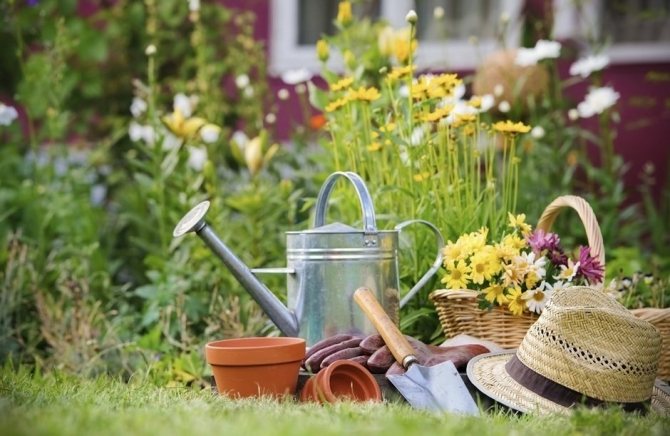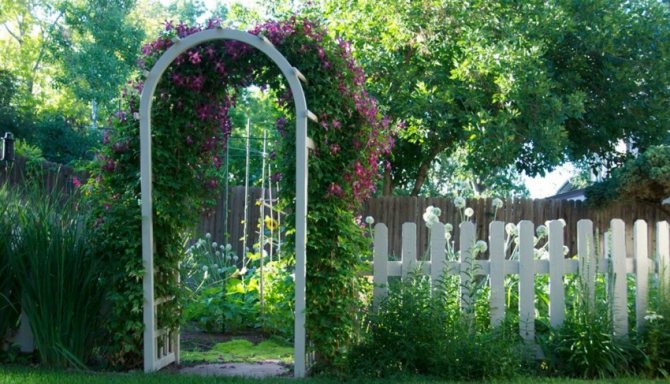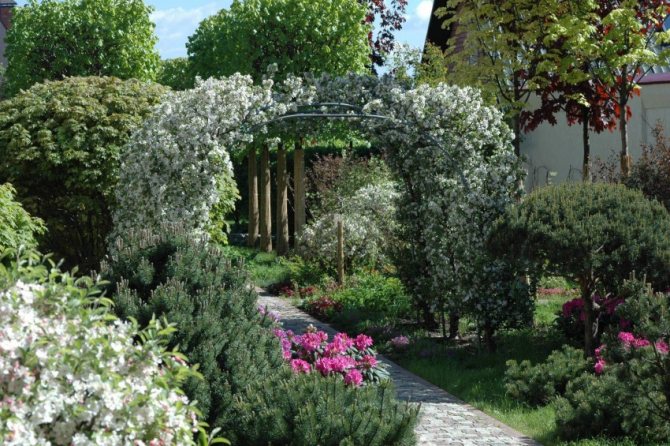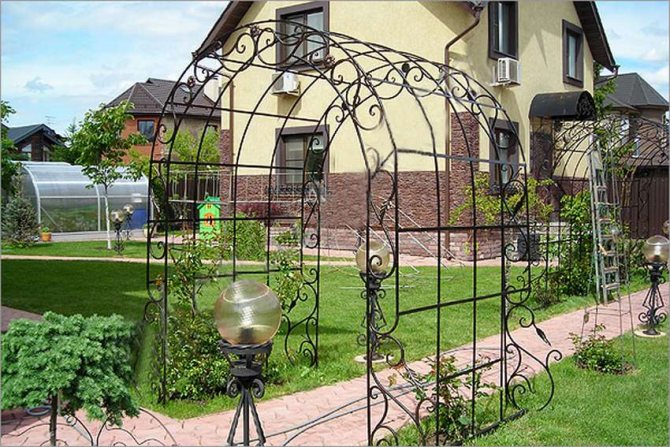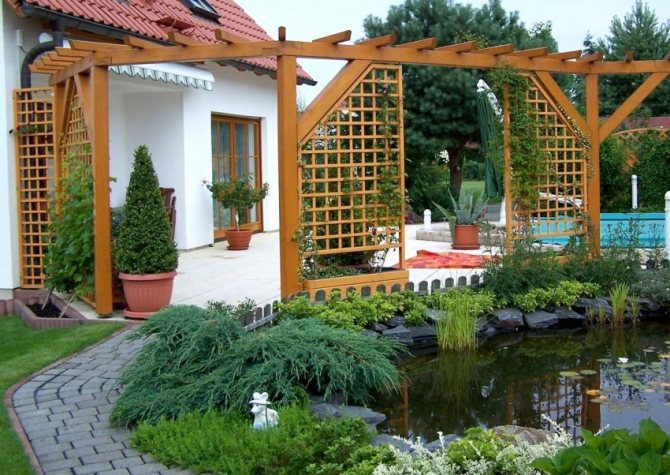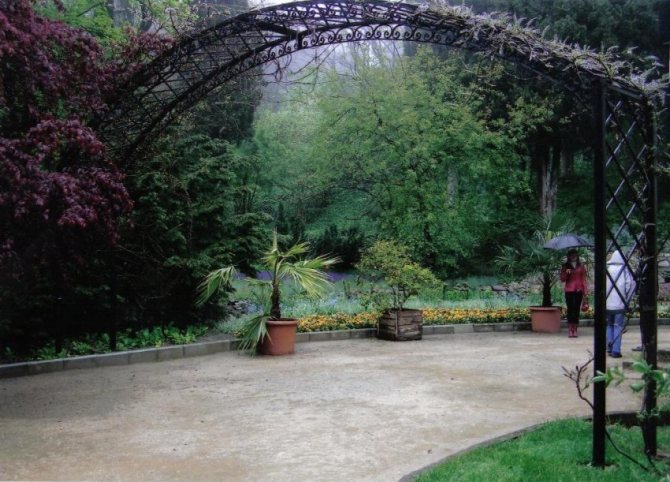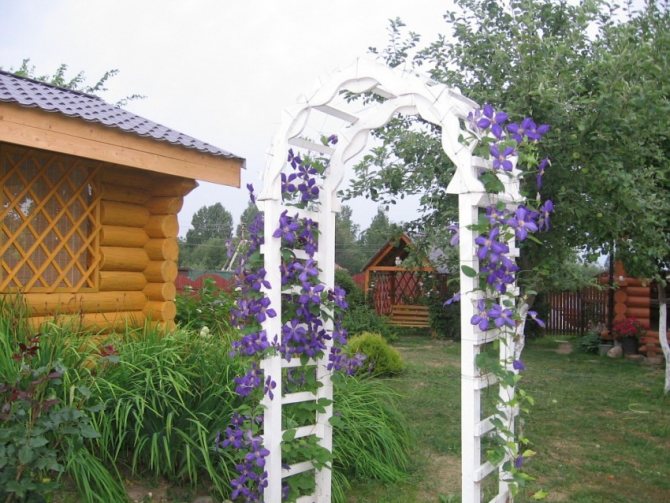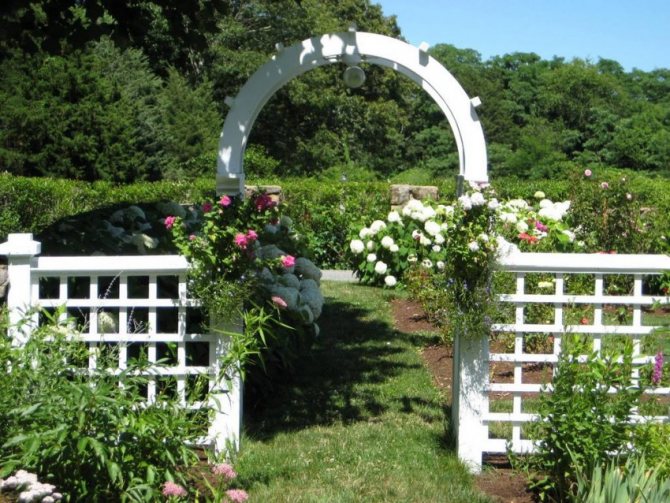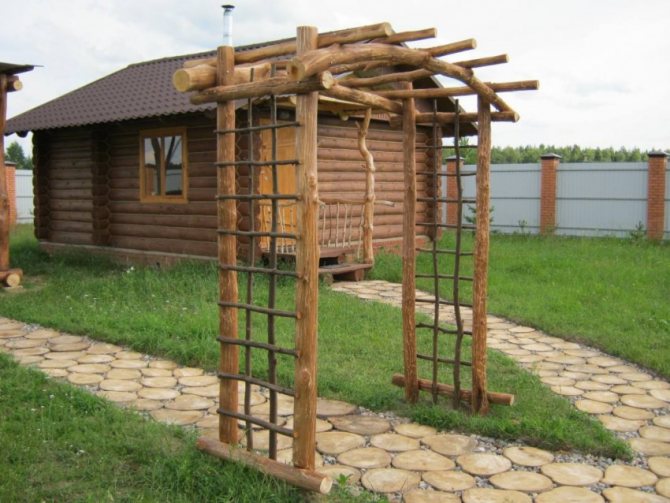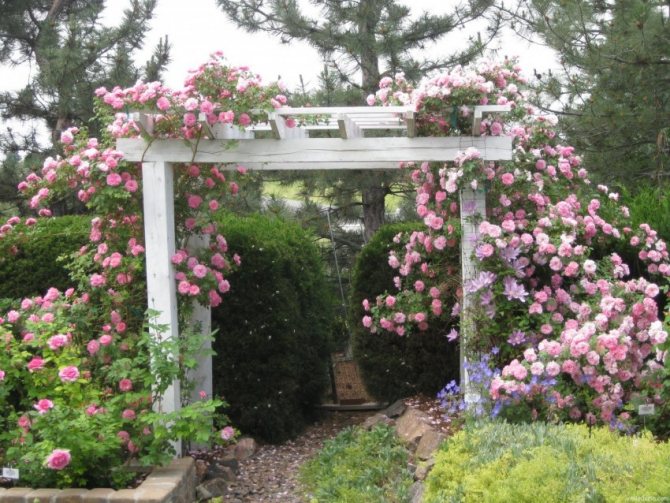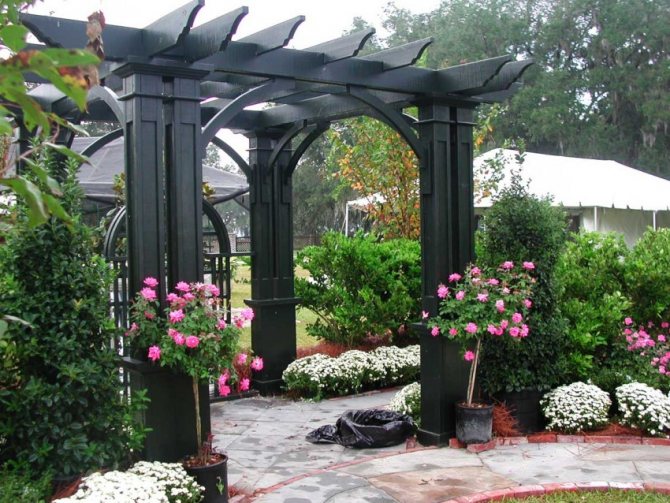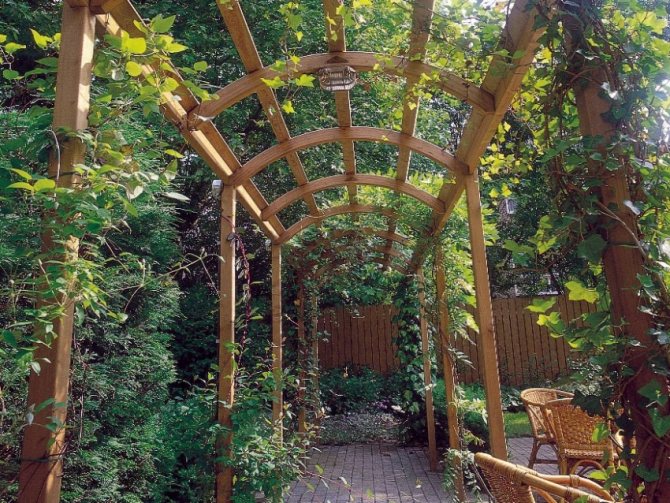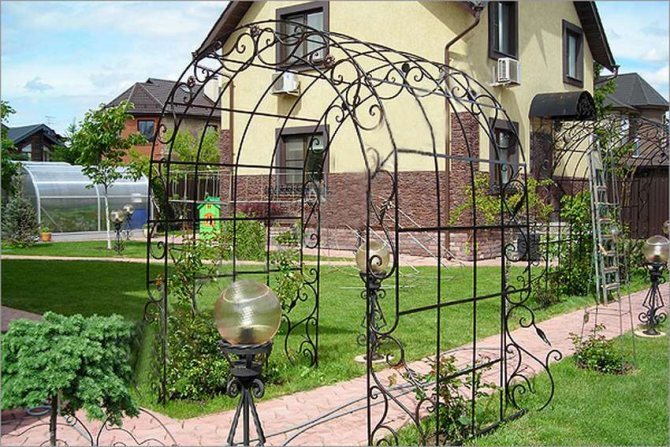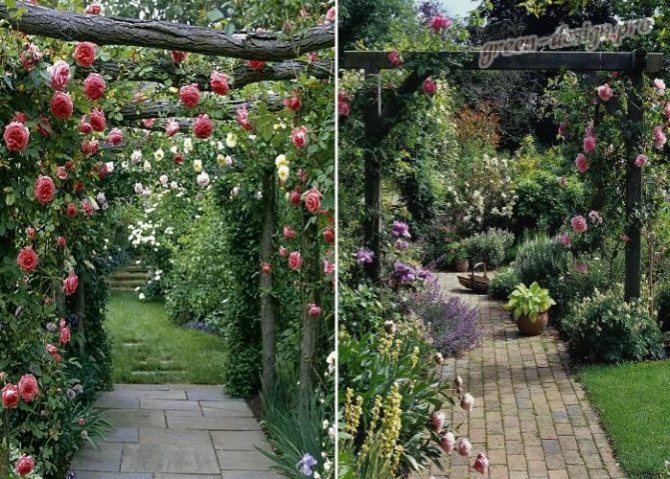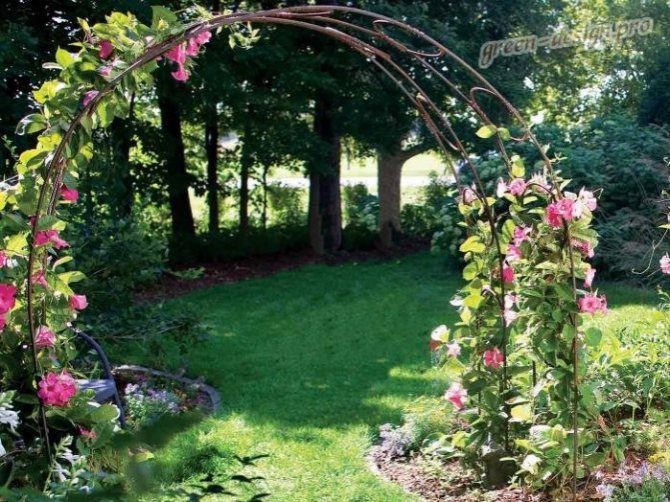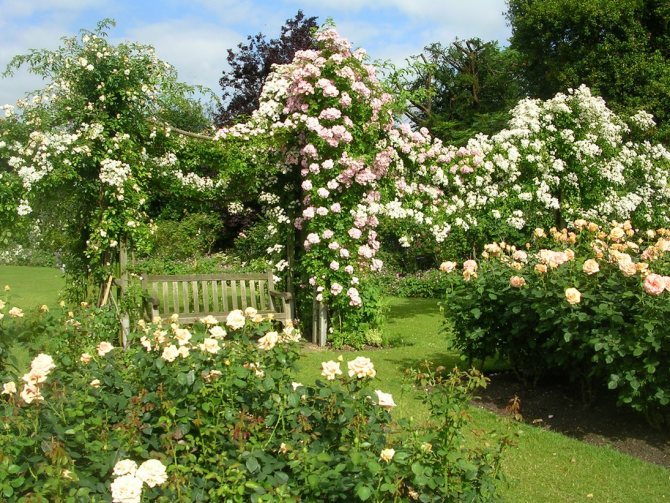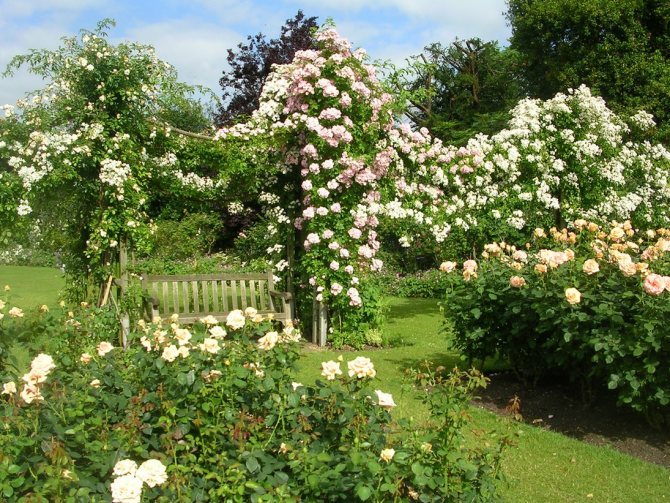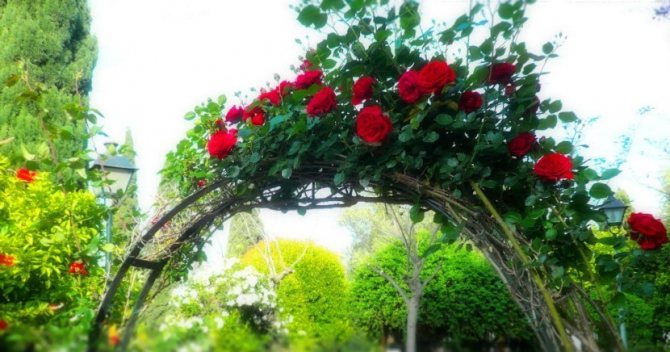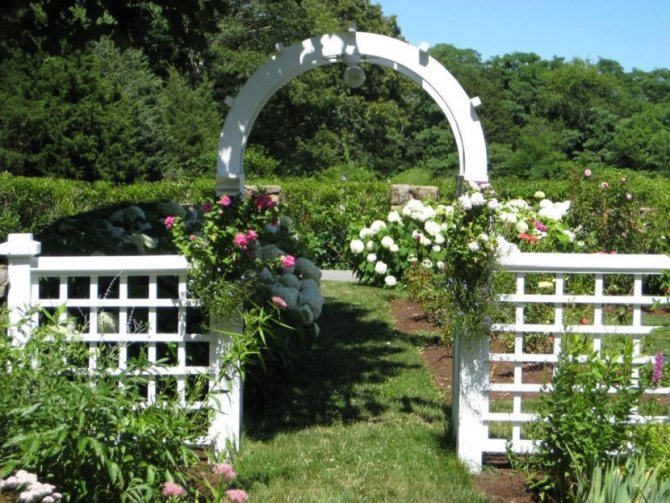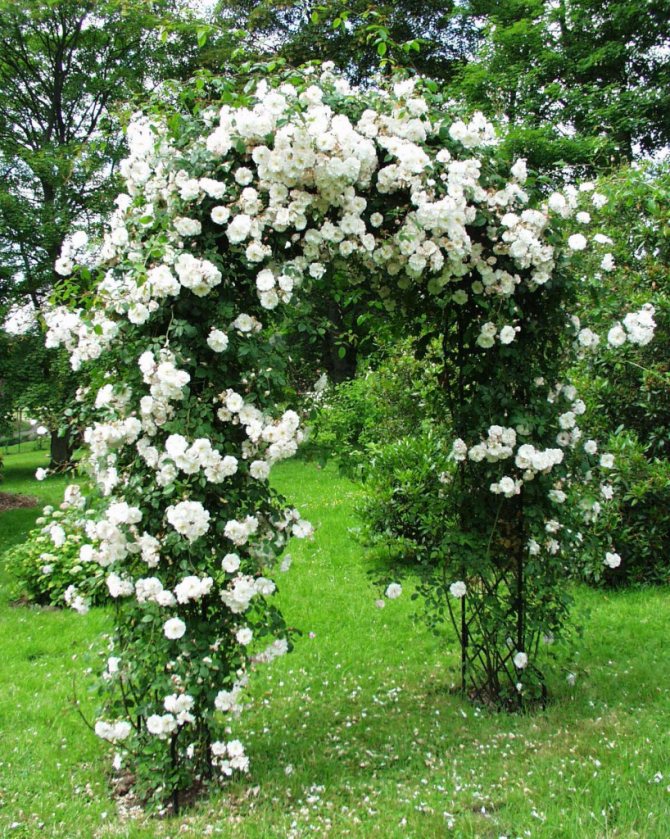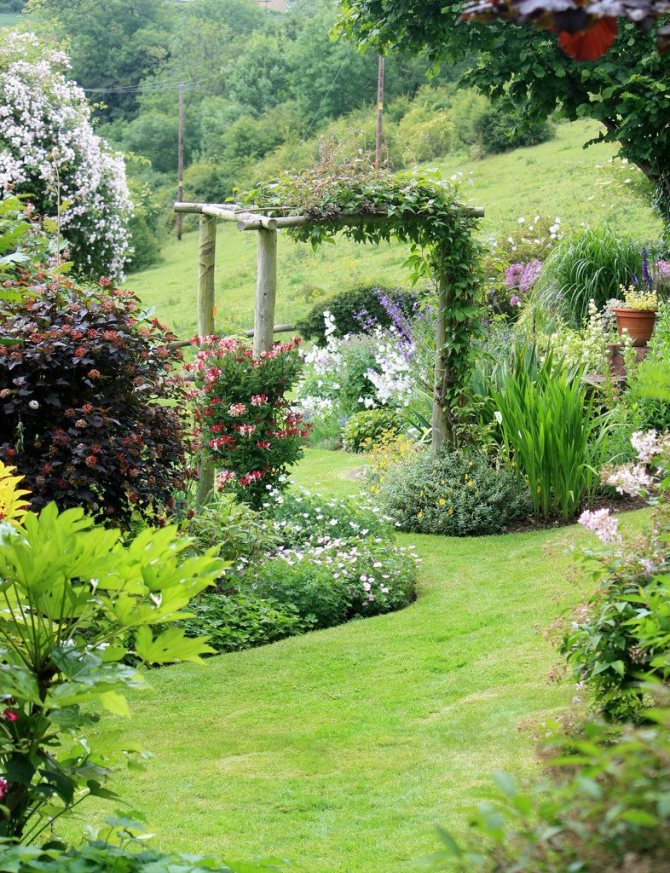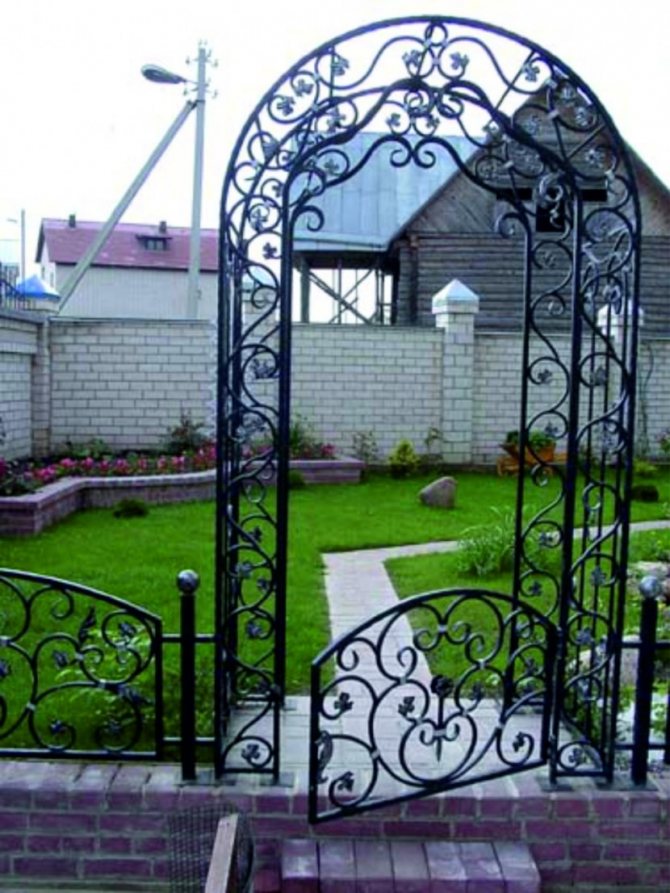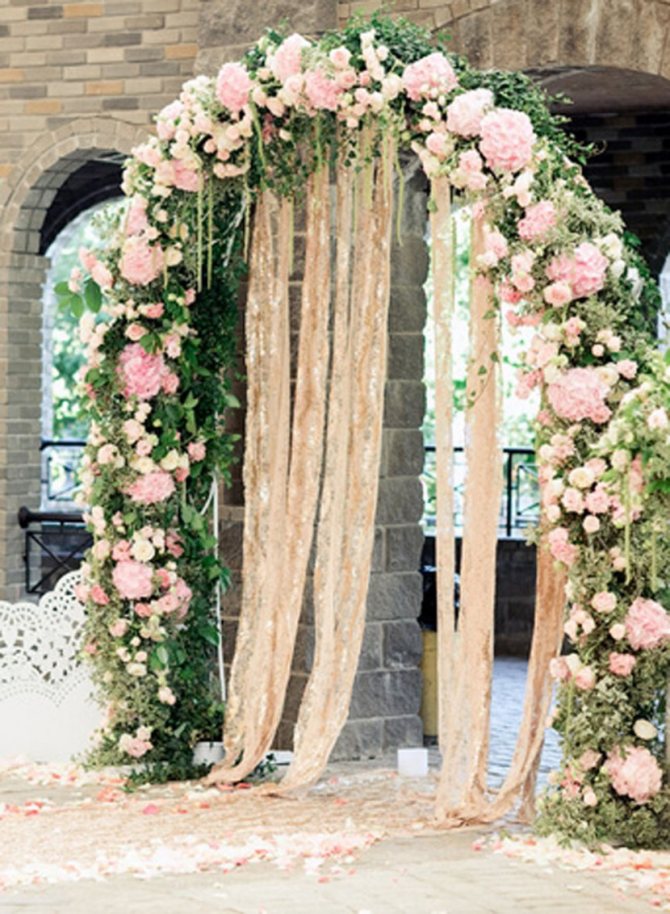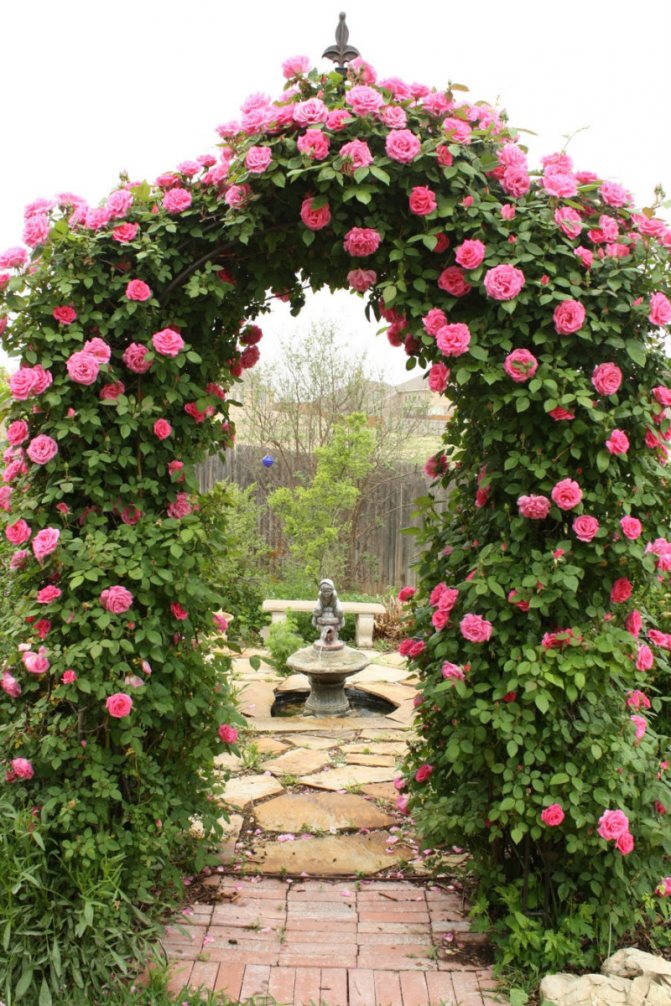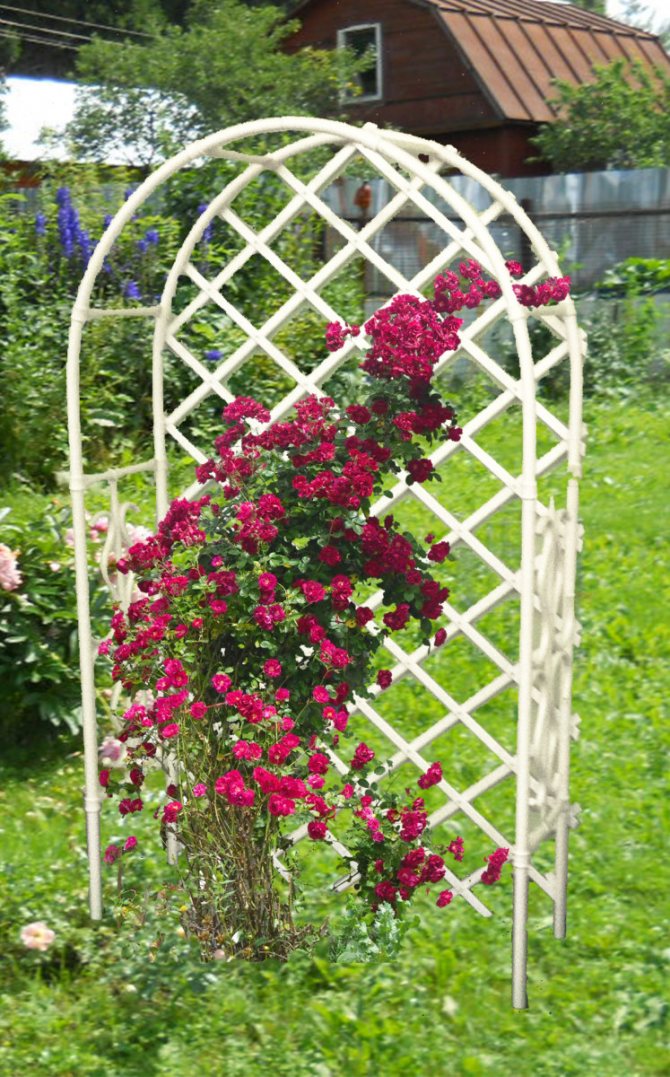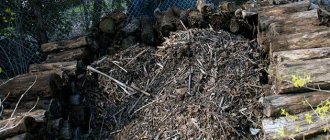The territory of the personal plot always wants to be made not only practical, but also beautiful. Spending time outdoors is doubly pleasant, admiring the beauty made with your own hands.
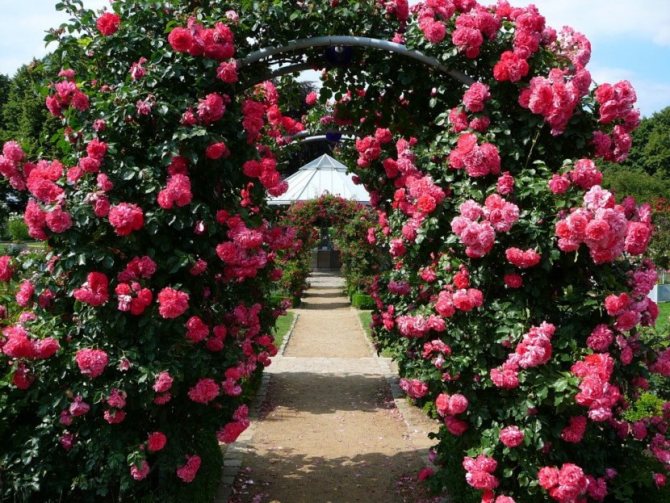
An arch will give a special atmosphere and coziness to any site. However, this design is not only a decorative element, but it may well serve as a means of zoning.
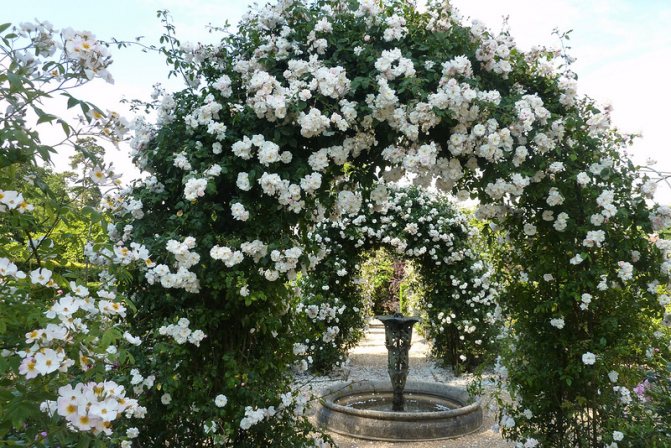

The arch can highlight the recreation area, creating secluded corners, or separate the garden from the vegetable garden. In addition, it is one of the most convenient methods for growing climbing plants.
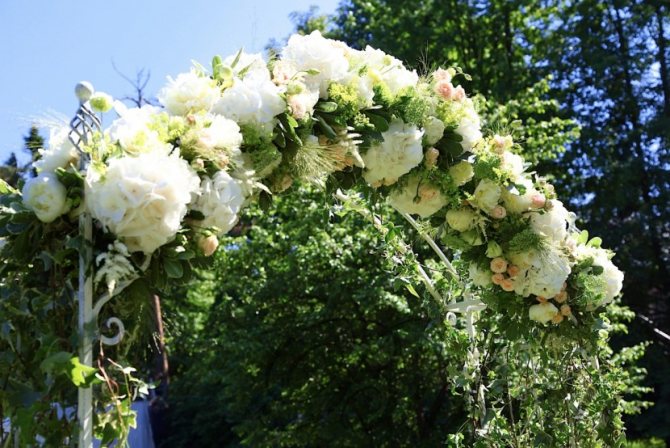

Support ideas for clematis
When a person sets out to find an idea for a support for flowers, the most unexpected materials can be used. For example, if you have wooden slats left after repairs, they can find a worthy use. We fill their gazebo walls. We start the plant on them.
Junk materials can also be used for support. If you have a piece of metal mesh, it can serve as a support. We fold the mesh into a cylinder and place it on the flower bed. After that, it is enough to plant clematis, which will curl as they grow.
You can make a sculpture of their metal rods or wire. The openwork frame will also become a beautiful support for clematis. Or you can pull a net on the wall of the house and let the flower curl along it. Thus, you will get a beautiful wall decor at home.
How to make a support for clematis with your own hands, step by step master class
Gardeners do not have to buy ready-made support structures, because they can be made by hand. The first step is to decide what form the structure will be made. Let's opt for a pergola, despite the name it is quite a simple support made of wood. It is an environmentally friendly material suitable for any landscape. All work is carried out according to the following rules:
- Wooden beams must be treated with antiseptics and compounds that protect the material from precipitation.
- For fastening parts of the support, it is better to take bolts and self-tapping screws on wood, this will ensure the reliability of the structure.
- The grille can be attached with staples or self-tapping screws.
Assembly and installation is as follows:
- marking the site, drive pegs in the corners of the future pergola;
- the corners are deepened by at least 90 cm;
- on the bottom of each recess we pour crushed stone with a layer of 10 cm;
- we saw off the racks of the required size and put them in the recesses;
- we check with a level whether the racks are evenly installed and fill them with cement mortar;
- after the cement has risen, we fasten the transverse beams;
- it remains to make a crate from the slats.
The pergola is ready. Now she needs to settle for a couple of days and it is fashionable to plant clematis.
Making a wooden arch
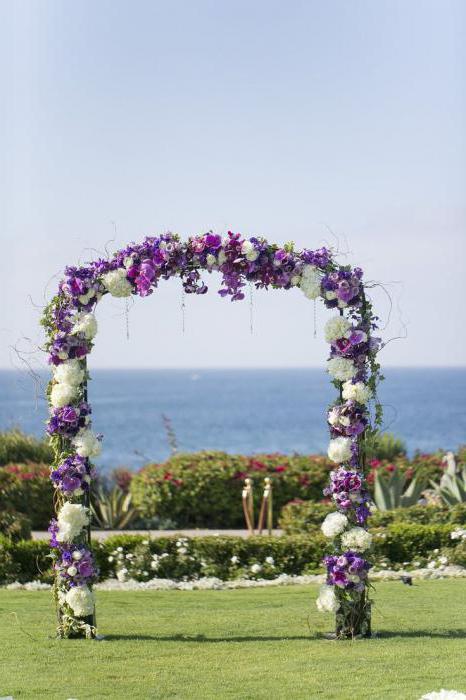

Arches for flowers made of wood for a summer residence look more harmonious, although they are not so durable. To do this, you can use a bar, the structure will turn out to be inexpensive and quite simple, and it will be possible to fit it into the exterior of any garden. This arch will have a height of 2.2 m. It consists of two vertical frames, one horizontal part and two inclined ones.
For construction, you should prepare:
- timber;
- wooden planks;
- metal corner;
- nails or screws;
- paint;
- primer.
As for the timber, four blanks should be made from it, the length of which will be 2 m.Four more blanks should have a length of 0.35 m.Two blanks will have a length of 0.65 m.As for the wooden planks, there should be 24 of them, the length of these elements is 0.65 m. Two more wooden planks will have length equal to 2 m. The metal corner is prepared with a length equal to 0.25 m. There should be 4 such elements.
Beautiful props for roses
Every gardener wants to decorate his plot with flowers and ornamental plants. Roses of different varieties are very popular. The weaving variety of this plant looks very beautiful. So that it does not take up much space, it is necessary to take care of the support in advance. And of course, the support must be beautiful. Here are five beautiful rose supports:
Obelisk.
Support "umbrella".
Pergola.
Garden sculpture.
Forged screens.
How to make a support for climbing roses with your own hands, step by step with a photo
Supports for climbing roses must meet the following requirements:
- reliability, so as not to break under the weaving branches of roses;
- aesthetics, the support must be neatly made and fit into the general plan of the site;
- suitable for a specific variety of roses, a large arch will be inappropriate for a small plant with small flowers;
- compactness, necessary for small areas where every meter is profitable.
The best option would be to make it yourself. Since we need a solid structure, it is best to take metal as the material of manufacture.
You can take four rods of reinforcement and fix them in the ground. After that, we tie it with a simple wire in a circle with a step of 40 cm. For a more beautiful look, paint the resulting structure in white. This will prevent the support from overheating. As everything dries, you can plant a rose. As the plant grows, it is necessary to lay it along the rungs. So the support will be evenly wrapped in a rose.
The nuances of attaching branches to transverse battens
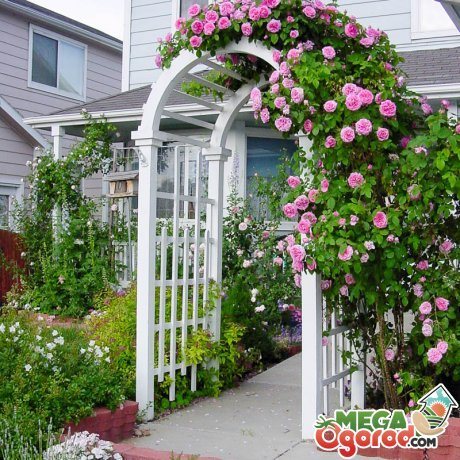

As the bush grows, the rose shoots are attached to the slats obliquely, and not clearly vertically. This will allow the bush to stretch not only straight up, but also in width. Form the bush during the entire growing season, otherwise the branches will only weave upward, and not along the entire width of the arch. Rambler roses are very easy to shape, their lashes are flexible.
It is important to constantly monitor the growth of the shoots and, during them, attach them diagonally to the arch slats.
The climbing rose on the arch is an amazingly beautiful sight. It is not difficult to build a structure and grow a luxurious rose bush if the basic rules for caring for the plant and installing the arch itself are followed. The only thing a florist needs to do is to be patient, as an arch entwined with roses takes time to grow. Already in the second year, the plant will delight the lover of beauty with its elegance and bright, lush flowers.
More information can be found in the video.
Support ideas for climbing roses
Having planted a climbing rose, you need to think about the support, otherwise all the beauty of the plant will be hidden. The choice depends on the landing site. If the rose is planted next to a building, it is enough to attach a plastic net to the building. It is along her that the rose will climb up.
Many gardeners fence off a part of the garden plot from the rest of the area intended for recreation. If there is such a fence on your site, it will serve as a support for the rose. It must first be painted white. After the paint has dried, we plant the plants. After a while, you will have a rose-scented hedge.
Another great idea is a rose gazebo. It is feasible if you have a welding machine and know how to work with it. It is necessary to assemble a frame from strong metal rods or pipes in the form of an arch. We deeply deepen the base of the structure and plant climbing roses. When the plant completely covers the arch, you can put a bench or a table under it.
What to choose?
For the design of a garden plot, you can buy architectural forms and garden arches on the market, made in various styles and decorative frames that have a luxurious look. These are beautiful and comfortable products. They are made from various materials. Such structures have some advantages as they are prefabricated and take a short time to install. The assembly process is carried out according to the instructions included in the kit.
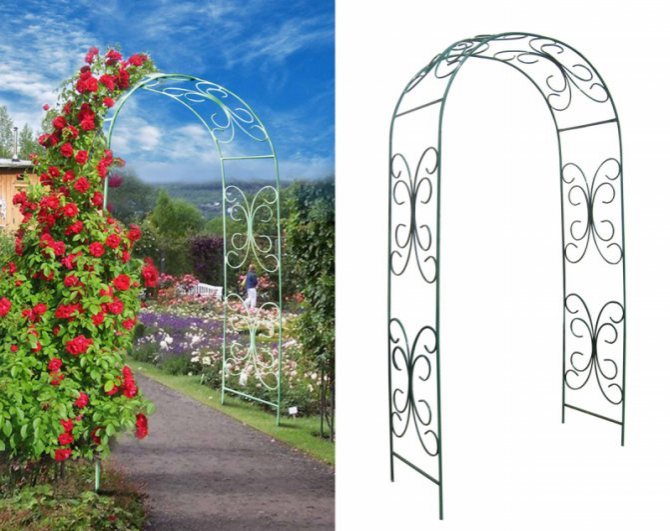

Purchased metal arch
But if you have some skill and desire to do something on your own, then when creating such a product, take into account that all work, starting from the choice of material, design dimensions and design style, depends on your own taste and preferences. In addition, finances are saved and in the end they get a finished product that they have dreamed of for many years.
Support for cucumbers
Cucumbers are best grown upright. This allows you to quickly and efficiently harvest, and also relieves unpleasant sensations on the skin. Various hangers can help with this. They can be made of wood. For example, you can build a support - a pyramid from a bar and slats. It won't take up much space.
You can also install poles on both sides of the garden bed and pull a net between them.
Or do it differently, put a pole and plant a string around it and tie it to it. After that, we fix each rope to the ground with small pegs. The distance from the pole to the rope is 60 cm. After that, we plant the cucumbers. As they grow, they will trail along the twine.
Supports for cucumbers with your own hands in the open field
With your own hands, you can make a variety of supports for cucumbers. If after the repair you still have plastic pipes and you don't know where to put them, now we'll tell you. We set aside a place where the cucumbers are supposed to be planted. After that, we fix two pipes about 2 m high in the ground at a distance of 1.5 - 2 m from each arc. On top of them we put another pipe with a length slightly larger than the distance between the pipes. On the sides of each of the vertical pipes, we also install supports with a height of 1 m.After that, we connect the side posts with an improvised ridge and mount the horizontal crossbars. Now you can plant cucumbers both in the ground and in containers installed on stands.
The easiest option is to install pillars or fittings on the garden bed along which the cucumbers will curl as they grow.
A chain-link mesh can serve as an excellent support. Having fixed it on the frame, we set it in the shape of a triangle on the garden bed. The plant will trail along it. It will also save space on the site.
detailed instructions
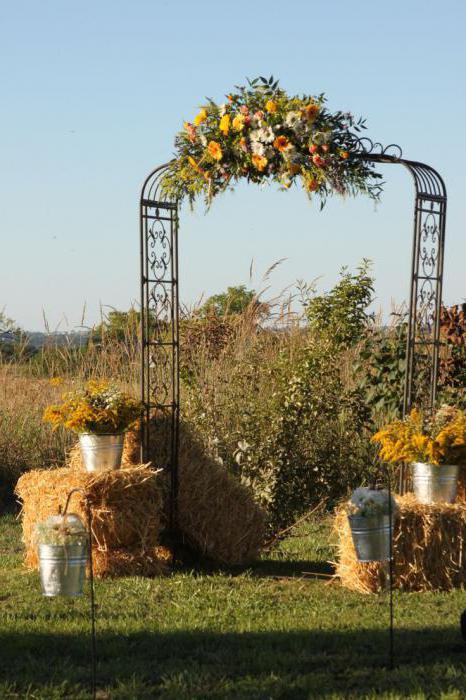

If you want to have a beautiful arch for flowers in the country, then you can use metal for this. The first step is to bend the 10mm pieces of rebar to create an arched opening. To do this, you can use a template of pins that are driven into the ground along the provided contour. The latter can be drawn directly on the ground. To do this, a rod is driven into the ground, a rope is tied to it, and then, with the help of chalk or paint, you can draw a semicircle.
Starting from its top point, it is necessary to drive the pins into the soil. This template is very easy to use. In order to give the arch the desired shape, it is bent around the pins. The bend will be smoother if flexible material is laid between the reinforcement and the pegs. To do this, you can use a chipboard strip or a strip of siding.
This model uses rings to connect the sections. They should be made of thinner reinforcement than the sections themselves. Separate pieces are cut from the reinforcement bundle, the length of which will be 94 cm. Rings should be formed from them using a pipe bender. If you do not have it available, then the design can be simplified by connecting the sections with straight edges. Such a garden arch for flowers looks simpler, but it turns out to be more functional.
The bent sections are installed in the soil, for this the reinforcement is driven in 45 cm. Having stepped back from the lower edge of the arch 61 cm, using a soft wire, it is necessary to tie the rings, observing the distance between them in the range from 15 to 20 cm.They will allow to connect the sections and fix the shape. To protect the arch from corrosion, a primer must be applied to the metal parts, and then a layer of oil paint.
Supports for cucumbers in the greenhouse
When planting cucumbers in a greenhouse, there are not so many support options. If the shape of the greenhouse is round or in the form of a house, then along the walls you can make a frame of slats. Having planted cucumbers, they will trudge along them, and the fruits will hang down. This will allow you not to clutter up the greenhouse and greatly facilitate harvesting.
In large greenhouses, you can tie up plants. A rope is stretched from the ceiling to the ground and secured. The plant, as it grows, is fixed on it with antennae and stretches up. As the cucumbers grow, they should be directed to the corn. Hooking, they will twine around the stem of the plant. Moreover, such a neighborhood has a beneficial effect on both crops in the form of an increase in yield. For cucumbers, corn serves as protection from wind and cold, which allows you to extend the life and fruiting of a vegetable crop. Also, the arch from the gate of the site can serve as a support. When the grapes grow, you will enter your house along a green corridor decorated with bunches of grapes.
The cost of forged arches
Wrought iron arches for flowers look, perhaps, the most elegant when compared with structures of another type. However, you can make them yourself only if you have special equipment and skills. You can buy one of these arches for 18,600 rubles. In this case, we are talking about a structure in the form of two benches, the backs of which are very high and are interconnected by an arched opening. Of course, you can purchase a simpler design, which will consist of two bent rods connected by forged elements. In this case, we are talking about an arch for flowers to the country house at a price of 4,500 rubles.
How to make a support for grapes with your own hands step by step, master class
The simplest and most convenient type of support for grapes is a trellis. It takes up little space and is easy to install. Now we will tell you how to make it on your site.
For this we need:
- 4 wooden posts 2.5 m long;
- 30 m aluminum wire;
- crushed stone;
- cement;
- tape measure and chalk.
Now let's get to work:
- on the site we measure out a rectangle 80 cm wide and 3 m long;
- at the corners we dig holes 30 cm wide and 50 cm deep;
- in each pit we install two pillars in the form of the letter V, and the distance at the bottom is about 80 cm, and at the top it should be 1.2 m;
- crushed stone is poured into each hole half the depth, after which we cement it;
- when the cement rises, it is necessary to pull the wire, the first row is pulled at a distance of 50 cm from the ground, between the other rows it is enough to make gaps of 40 cm.
By repeating this algorithm of actions, you will make a support for your grapes.
This article describes the types of supports for both weaving flowers and vegetables and grapes. Using the information provided, you will select a suitable support or you can make it yourself from scrap materials. Good luck with your work.
Climbing roses are some of the most beautiful, graceful varieties in the world of flowers. They are able to decorate any place. Dacha is no exception. Landscape designers often use a bush variety to decorate gardens and parks. That there are only one arches created from these graceful plants. And the hedges of climbing roses! The variety of color variations, the competent combination of which can transform the space, is surprising. This article will go into more detail on how to tie climbing roses.
Making a metal arch
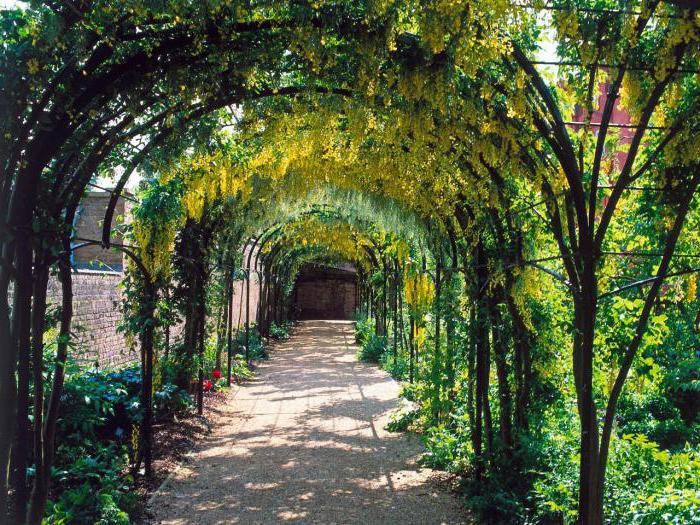

Metal flower arches are among the most common.They are durable, and if covered with appropriate compounds, they can last a very long time. The simplest model is the variant, the width and height of which are 1830 and 2130 mm, respectively. It is necessary to use reinforcement sections for work, which are pre-bent into arcs and interconnected with metal rings. You don't have to use a welding machine for this, and a thin wire is used to connect the parts.
The step between the arched sections should be equal to the limit from 31 to 32 cm.In order for the structure to stand in place as firmly as possible, its elements are dug into the ground at least 45 cm. A distance of 15 cm is observed between the rings, which will act as cross-bars. The diameter of the rings themselves is 30 cm.
General rules for the care of a climbing (curly) rose
In order for curly roses to become a decoration of the space, it is necessary to provide them with decent care. In case of careful and careful attitude, these "royal flowers" will delight you from year to year. They also have a gorgeous, delicate, graceful scent that contributes to the overall enchanting atmosphere. Having seen just once how climbing roses bloom, you will want to plant such flowers in your garden.
How to tie a climbing rose
For this variety, three components are extremely important:
- Top dressing;
- Watering;
- Pruning.
Top dressing
There are plants that can easily do without fertilization. Roses of this variety do not belong to this category. They love to be fertilized. Literally before our eyes, they are transformed from "proper feeding". First of all, you need to feed the roses after pruning in the spring. The best fertilizer in this case will be rotted manure and ammonium nitrate. In size: 3 kg of manure for a bush and 25-30 grams per 1m2.
After 14 days, it is worth carrying out the feeding process with other means: mullein - 3 liters, potassium salt, ammonium nitrate 10 grams each, superphosphate - 40 grams. The soil is fertilized with this mixture. When the roses begin to bloom a second time, add ash up to 100 grams per bush, superphosphate - 40 grams, potassium salt 15 grams.
Watering climbing roses
On average, flowers are watered once a week. Here it is also worth considering factors such as weather conditions. There is a nuance in watering technology: you need to water slowly, slowly, at the very root. This watering will prevent the formation of superficial roots. The most favorable time for watering is early morning.
Watering a climbing rose - be sure to observe the measure. Towards autumn, watering should be reduced. Waterlogging of the soil can lead to plant diseases. No watering procedure is required in October. Winter is easily tolerated.
Pruning climbing roses
Pruning for this variety of roses is essential. For crown formation, lush and abundant flowering and maintaining a healthy crop.
Pruning a rose
Pruning should be done carefully so as not to damage either the plant or yourself. You need to use a well-sharpened tool.
In some cases, pruning has its own characteristics. General basic rules for pruning:
- Using a sharpened cutter;
- The cut is made at an angle and at a distance of 5 cm from the kidney;
- The cuts are done very carefully;
- Timely need to remove dry, frozen stems;
- Shoots that have not received development should also be removed.
Why do they make supports for a climbing rose
The question may arise: "What is the support for the climbing rose?" The fact is that climbing roses lack any hooks on the stems so that they can twist around them on their own. They need to be fixed on the supports, setting a certain direction, fixing on the supports. Fastening climbing roses solves problems such as:
- Creation of a beautiful bush shape;
- Abundant flowering at full height;
- By making the crown more rare, this ensures a favorable climate inside the crown;
- Healthy stems and foliage make climbing roses look even more beautiful.
How to tie roses to a support
Rose support
Best of all, in order to avoid additional worries, it is worth giving the shoots the desired shape in advance. Immediately you need to install a support when planting a seedling. This will eliminate the likelihood of damage to the emerging root system of the plant.
Note!
You can give any direction to the stems, trying to get the maximum decorative effect.
There are several options for fixing a climbing rose:
- Horizontal garter - on a lattice or trellis;
- Spiral-like - strapping a post or other vertical support;
- Vertical - along tree trunks, arch columns;
- Fan-shaped - next to a wall or hedge.
“In the springtime, climbing roses definitely need time to set buds on horizontal shoots. There is no sense in rushing to lift from the support. You need to wait a while for the buds to appear up to 3-5 cm on the second-order shoots. Once I tried, without waiting for the young shoots to grow back and decided to attach them to the support. As a result, the entire pipe was practically bare: there was no flowering. Once again, I was convinced that you need to wait until the kidneys swell.
When placing climbing roses on a support, it is required to take into account that the laying of pink shoots occurs at an angle of 30 degrees. In accordance with this, they are placed on the supports.
In the case of a horizontal arrangement, the growth of lateral branches will increase, which are absolutely unnecessary in this case.
Additional Information!
When the branches are directed at an angle, in a spiral manner, it promotes better bud formation. Flowering lasts a long time.
With the vertical arrangement of climbing roses, you will need to artificially create branching, because the flower will grow in length. Here it will be necessary to bend the top of the plant to the bottom to change direction.
A rose bush can be formed in the form of a fan, which will become a screen, partition, or will act as a decoration for walls, fences.
Climbing rose on the partition
It's important to know
The support for the grapes must be approached carefully, since with the correct construction it will be of great benefit. Some rules should be taken into account so that the structure will last for a long time.
It's important to know:
- Supports for grapes should be placed from north to south. They do this so that the bushes are illuminated by the sun on both sides equally.
- Periodically, you need to treat steel parts with a product that fights against corrosion. Wooden elements are treated with preparations that destroy the fungus.
- The tapestries can be deformed or sag. To prevent this from happening, fortifications are made using transverse axes and crossbars.
Supports can last a long time, while only benefiting the plants. This requires spending more time on their construction, including imagination, and taking all measures to protect the material that was used. In this case, the vineyard will delight its owner, bear fruit, and develop for a long time. There are many factors to consider when making supports for other climbing plants.
Do-it-yourself rose arch: a detailed guide, diagram
On a note!
The arched version is very suitable for garden decoration. The arch itself fills the space with a certain mystery and elegance. When she is wearing climbing roses, this is an unforgettable view.
Most often, arches for climbing roses are placed near the entrance to the courtyard. This is not the only place where she "will have to the court." An excellent location would be a place next to the gazebo. Arches are usually made of wood, metal. The plastic version also has a place to be. The strength of this material is poor.The most durable are forged arches. They are mainly used as a support for climbing roses.
In order to make a support with your own hands, you need to decide on its purpose. You can pre-create a drawing. Will it only serve as a decoration on the flowerbed or will it be an entrance, a place to rest. The purpose is taken into account when choosing the material and thickness of the bases, cross battens. Below are recommendations on how to make an arch for a climbing rose with your own hands.
Algorithm for creating an arch with your own hands
Which arch to choose?
Each material has its own advantages. So, a tree looks great in combination with green leaves, flowers. Thick stems are usually attached.
Note!
For metal arches, graceful thin stems of roses with small flowers are better suited.
What is better to make an arch for a rose yourself or buy a ready-made one?
It depends on the size of the arch, the availability of construction skills, the amount of free time and financial capabilities.
If making such an elegant garden accessory is a pleasure, and inspiration is available, then you can safely create it yourself.
The arch with climbing roses entwined around it will become a unique decoration of the garden. It is worth the effort and time.
Every gardener needs to know how to tie up a climbing rose so that it pleases with its flowering and thin stems do not break from improper support.
Today you can find many interesting decorations for a garden and a summer residence, but nothing beats fresh flowers. That is why summer residents begin spring work with arranging flower beds and improving the territory. If you are planning to plant flowers, we suggest finding out how to make supports for climbing roses
and other plants. Even from improvised materials, you will be able to make original props that will succinctly fit into the design of the site.
Construction of plastic pipes
The construction of this material has a guarantee of over 50 years, and its cost is quite low. Therefore, when performing such a product, you need to know about the features of working with this material and follow the recommendations of specialists.
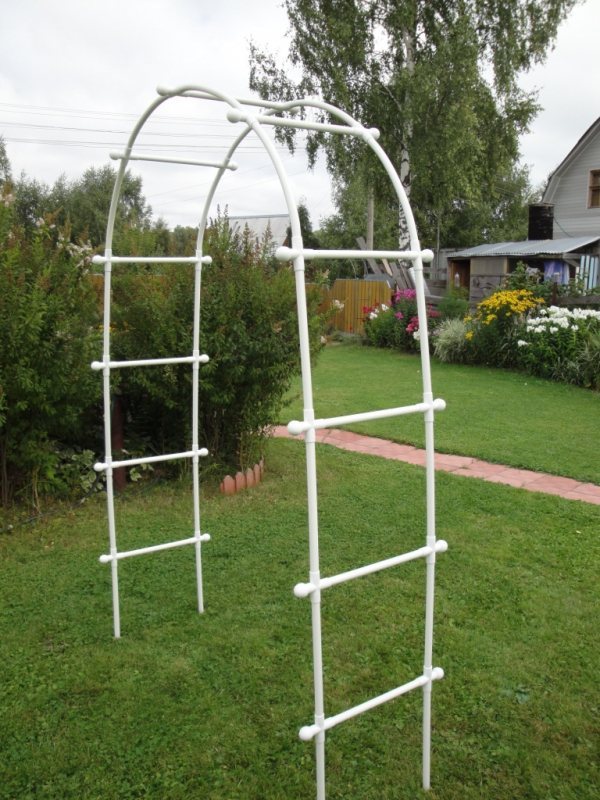

Arch made of plastic pipes
They advise:
- take accurate measurements of the terrain;
- calculate the dimensions of the future structure;
- draw a sketch of the arch and then create a drawing.
The main part of the structure in this case consists of plastic pipes that are connected with appropriate fittings. For a more reliable fastening of parts, a special device is used - a soldering iron-iron, which has several nozzles.
Next, the following work is carried out:
- 1Pipes are cut into fragments according to the dimensions indicated in the drawing.
- 2Select the appropriate adapters.
- 3 Degrease the joints.
- 4 The necessary parts are put on the soldering iron nozzles, heated to the desired temperature and connected to the adapters. All joints are checked only after the parts have cooled.
- 5If there is no soldering iron, then use a special glue. In this case, the surface of the main part and the inside of the fitting are coated with a compound, withstand a certain period and connect the parts by turning them a little.
- 6After all parts are securely fastened, the structure is installed. To withstand gusts of wind and other natural influences, the structure is sunk into the soil by 40 or 50 cm.
- 7 The base of the arch is covered with earth and tamped.
In winter, this structure is removed to the barn, otherwise frost can destroy it.
Types of supports for climbing flowers and plants in the country
Supports for climbing roses can be made from a wide variety of materials, it all depends on the available budget. Weaving flowers look beautiful in arches, as well as on straight supports and ladders. Quite often, summer residents use a trellis net, which fits perfectly into almost any landscape design.This material is considered one of the most budgetary, while it is easy to use, light enough and suitable not only for roses, but also for other plants.
You can make a trellis mesh for yourself. To do this, you need to find a suitable place, then dig in metal or wooden poles at a certain distance, and then pull the mesh. In order for the structure to fit into the design of the site, paint the pillars with a suitable color. The trellis can also be made entirely of wooden boards by nailing them with a net between the beams. With the help of a trellis, you can form a climbing rose bush with your own hands.
- an ideal solution for owners of spacious summer cottages. You can also make such supports with your own hands. Pergolas in appearance are a lattice roof, fixed on pillars. The length and width of such a support depends on your design idea. Poles can be made not only from wood, but also from metal. The advantage of a climbing rose pergola is that it can serve as an additional gazebo.
Arches for climbing roses are smaller and differ in curved shapes. They can be installed at the entrance to the garden or to decorate the surrounding area. Forged arches or wooden arches are often made as a support for flowers.
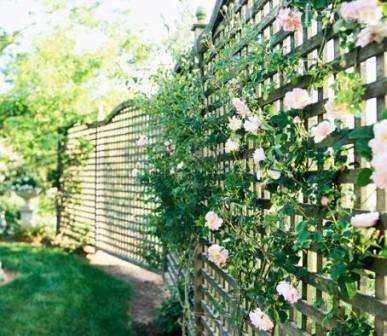

Poles made of wood or metal can also be used as a do-it-yourself support. In this case, it is necessary to dig deeply the pillar into the ground so that it serves as a solid support for the roses.
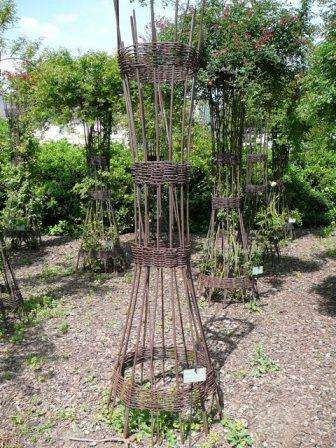

You can use a fence, stones or other materials as a support for roses, it all depends on your design idea. Knowing how to make supports for climbing roses and other plants, you can decorate your site and give it a touch of originality.
Climbing roses occupy a special place among all the variety of related plants due to the abundance of flowers and the possibility of incredible location. The most bizarre shapes of these amazing flowers create supports for climbing roses. Since they themselves do not curl, it is the support for the roses, along which they are guided and on which the shoots are fixed, that is decisive for the design of a flower garden, garden or park. Summer residents usually arrange their plot so that all structures can be made by themselves, the support for a climbing rose with their own hands is no exception.
Using climbing roses, summer residents often want to create a shady resting place, decorate an entrance to a plot or alley, if space permits, they decorate fences and mask unsightly buildings with them. With the help of vertical supports, the rose is made the central figure of the flower garden or even the entire garden.
But when choosing a place for such a design, you need to remember that a rose is a delicate plant with its own needs and preferences. Therefore, it should be planted where it will be possible to provide a sufficient amount of light, where water will not accumulate, flowing down from the entire area, where groundwater does not come close to the surface. Otherwise, if you plant a rose in the wrong place for it, then you will not have to enjoy the wonderful flowering, but to treat it for many diseases, admiring only the prepared support, not entwined with lush branches.
Climbing roses are divided into shrubs and ramblers, which are very different from each other. So most varieties of scrubs have powerful, thick, practically rigid shoots that grow up to 2 meters or more. They have an amazing aroma and large flowers. And flower growers, among other advantages, especially note the small number of thorns. At first glance, their bushes do not require support for growth, but they do need it, because heavy flowering branches can break under their own weight and the actions of the wind. The support will not only support the shoots, it will help them look really great.
Rambler without support will grow poorly and will not look at all the way they deserve it.Their thin flexible branches grow up to 4.5 meters, they are covered with small, abundant flowers, which look very decorative on supports of fanciful or very simple shapes.
In addition to the place convenient for the rose itself, the place should allow fixing the support so that it can withstand not only the weight of the rose, but also can withstand strong gusts of wind. If roses are supposed to be put on the wall, then the support should be at a distance of 25 cm from it, a smaller distance will not provide air circulation.
What a landscape designer can advise
- As a material for making a support, you can use metal, wood, plastic and even stone pillars. In this case, you need to take into account the design, variety of roses and the cost of the request;
- Bars of horizontal shape should be installed with a gap from each other. not less than half a meter... In the event that the bush begins to branch strongly, then it is better to add crossbars;
- Roses that have large flowers can have a great look even on huge spherical bearings... And for flowers with small buds, vertical stands will also be suitable;
- A rose will be enough for vitya a fence made of wood or even a barn... At the same time, it is necessary to plant flowers half a meter from the fence (or shed) and install special parts for additional support.
- The support in a mandatory form must be processed and painted. In the worst case, roses will carry a variety of infections.
How to dig in a support for a rose
In order for any rose bush to trail, a large number of different structures may be suitable. For a more convenient tying of shoots, they should have horizontal bars or lattices.
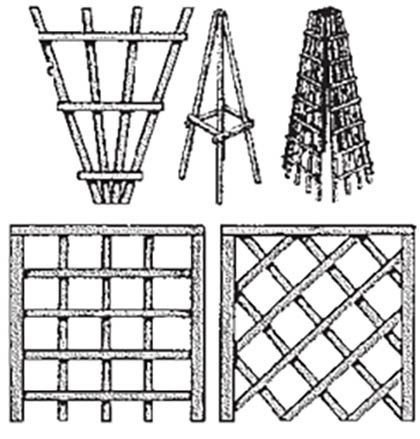

The trellis support must be characterized by such parameters as strength and stability. Otherwise, the wind can overturn such a structure without any problems.
Regardless of which option was chosen as the support of the climbing rose bush, it is necessary to plant these flowers correctly. Do not forget about caring for this plant. You need to make sure that the roses are trailed correctly, cut off excess shoots in a timely manner and feed your own roses with a variety of fertilizers. Then these flowers can decorate every building and the entire garden.
Varieties of supports
The forms of the supports are very diverse, but they are based on several basic varieties, which the designers play around depending on the desired result. The main ones are arch or pergola; trellises, which can be in the form of a vertical wall, pyramid, ladder, or just a lattice; pillars or monuments.
When building a support, you need to remember that climbing roses themselves do not curl and do not cling to the support, they must be consistently directed in the right direction and fixed on the support. In addition, there is a very important secret of flowering - flowers are formed not on the main shoots, but on short, usually, branches that extend from them at a right (or almost) angle, and these young branches always grow upwards. Therefore, the main shoots should be placed horizontally or at least at an angle of 45 degrees to the ground line. This must be remembered when braiding the support. You cannot direct the shoots vertically upward, then the flowers will appear somewhere high, there will be few of them, flowering from June to September will not work. And, of course, the bush must be freed from the already faded roses, which stimulates the formation of new buds.
You need to build a support before planting a plant, so that later you do not damage the roots of a rose already growing in this place.
Arch
Arches are erected at the entrance to the site, to the gazebo, house or some area of the park. A do-it-yourself rose arch is usually made of wood or metal. The tree always looks great among flowers, it is used to support massive stems, and metal structures are often twisted with thin delicate shoots.Wooden arches covered with varnish or paint can last more than 10 years, and metal arches at least 15 years.
Support pillars must be fixed in the ground thoroughly, in some cases they even make a concrete base. For the arch, a vault is made, and for the pergola, a lattice (most often wooden) is installed according to the type of roof. The pillars must be at least 1.80 m high, wooden blocks or metal rods are installed around them in a circle at the same distance, they are fixed on the base and the upper beam. It is along them that the growing shoots of roses will be directed, they will curl on a pole in a spiral, located almost horizontally. Two shoots can be braided towards each other, they will be covered with young twigs with flowers.
For the pergola, you can use a removable rope net or a lattice made of wooden slats. This design will make it easier to cover the bush for the winter, its main part will simply be removed along with the trellis or net.
Trellis
The trellis is placed against the wall or in the middle of the garden, separating different zones. It can be just a rectangular structure, consisting of a sturdy frame, usually wooden, and a lattice located (fixed) within this frame. Summer residents usually use metal wire or wooden planks for the lattice, which look great among the greenery of the rose, if painted with white paint. Less commonly, plastic purchased gratings are used. The trellises are arranged in the form of a fan or give them a bizarre shape, which the rose bush itself acquires, hiding the trellis under it.
You can simply dig vertical posts of the required height into the ground, usually from one and a half meters or more. Holes are made in them along the entire height every 20 - 50 cm from each other, nails curved with hooks are inserted with the help of pliers. A wire is pulled over these resulting hooks - and this is the simplest frame. It must be disinfected and painted.
On the trellis, it is not necessary to place roses on one side, shoots can be threaded through the lattice, then a blooming wall will turn out on both sides. This is not very convenient for caring for covering roses - in the fall it will be difficult to untangle them in order to fold and cover for the winter, and if the roses do not need such insulation, then the double-sided flowering trellis will look very impressive.
The netting, laced with the shoots of a climbing rose, can be an example of a simple trellis, but it can also be a magnificent hedge, completely hiding under the leaves and flowers of a lush plant.
Pillar
The pillar as a support for roses can be of any height, be in the middle of the flower garden, thus placing it in two planes, or it can stand near a bench or a gazebo, delighting the eyes of the resting owners and arousing the envy of their guests. In parks, they make an excellent composition, placing the pillars at the same distance from each other along an alley or path, connecting them with a beautifully sagging rope or chain. Roses, twisting pillars, picturesquely hang from these chains in blooming garlands.
The pillar can be made of any material, in summer cottages it is, as a rule, wood, and in parks there is anything you like - wood, metal, stone. But around this central support, metal or wooden horizontal circular fragments should be located, on which the shoots weaving along them will be fixed, so that the branches spiral upward, and then also go down, if the length of the shoots allows.
According to this principle, not just pillars are erected, but pyramids or other elongated structures, usually referred to as monuments.
Supports, whatever their shape, are designed not only to support climbing roses, but also to help them look in all their amazing beauty, decorating the garden with themselves.
Choosing plants for decoration
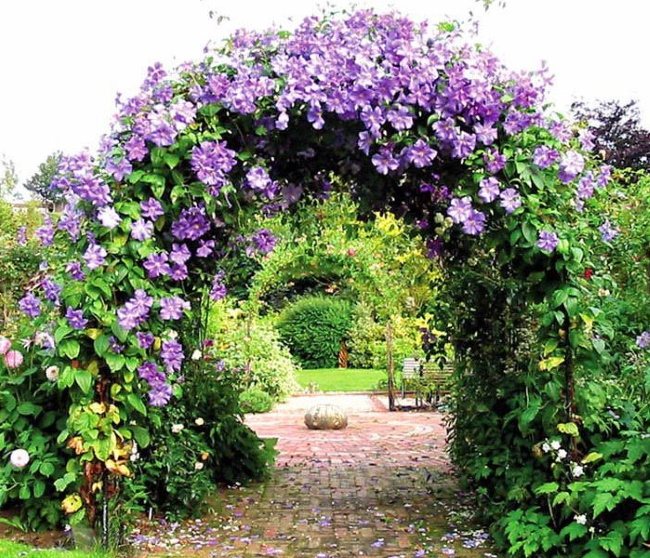

To complete the design of the arched composition, climbing plants are planted next to it. Climbing annual crops grow very quickly.During the summer season, they completely wrap their whips around the vault and side surfaces of the decorative structure. Kobea, ornamental beans, bindweed are suitable for quick landscaping. If the arched structure is not disassembled and sent for storage in the fall, landscaping is performed from perennial crops - clematis, honeysuckle, climbing rose, wild grapes, and impomoea. They have a lush bloom and a strong aroma.
As they grow, the shoots of branching plants are intertwined through the lattice, forming a green vault in the form of an arched structure. Green spaces are regularly watered and fed with fertilizers. Faded buds and broken shoots are periodically cut off so that the arch retains its decorative effect throughout the season. In the fall, dried annual plants are harvested. Perennials are carefully removed from the lattice, folded and covered for the winter with spunbond or branches of conifers. In winter, snow is thrown on top.
Advice!
In order for the result to be optimal, a combined landscaping option is used. Perennial crops are planted as a basis. Annuals are located next to them. Then the seasonal greenery entwines the side grilles and the vault in a few weeks. Then it will be replaced by the shoots of perennial plants. With the right shelter for the winter, they are preserved for the next year. With the onset of spring, the shoots are straightened and re-fixed on the lattice.
